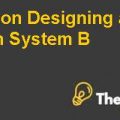VENDING MACHINES – MONTE CARLO SIMULATION (HOMEWORK ASSIGNMENT 3) Case Solution
Problem Diagnosis
One of the manufacturing companies is considering launching a new venture and the main business of this venture would be to install a number of the automatic vending machines in the various locations of the major city where the venture would be created. The management has two options of the vending machines which could be designed. These are the Ultra Vend 3000 and the Vendomatic Deluxe. Although the designing of the machines would cost the same amount of money however, the main difference lies in the ease of repair and the frequency of the repairs of each of the machines.
Moreover, when any of these machines breaks down, it would then result in the loss of the sales for the customers until the machine has been fixed by the field technician. There are also differences in the repairing times and its cumulative probability distributions. In order to determine the best course of action for the new venture, a simulation model needs to be constructed and Monte Carlo Simulation has been performed in this report to determine the best vending machine option for the new venture which results in the minimization of the costs per month and maximization of the EMV.
Assumptions & Model Creation
The simulation model has been generated in the excel spreadsheet. The model for determining the costs per month for each of the two options is as follows:
Cost per month = (number of breakdowns per month) x (repair duration in hours) x (sales lost/hour)
It could be seen that the above three variables are all uncertain in this case. Therefore, based upon the nature of the data provided for each of these three inputs, random distribution functions have been used in SimVoi to formulate the simulation model. The distribution function which has been used for the breakdown frequency is the randdiscrete function because we are provided with a range of the breakdown values with their respective probabilities. Next, for the repair duration we have used the randcumulative distribution function since we are provided with the cumulative probability for each hour of the repair duration.
Finally, for the sales lost variable the randtruncnormal function has been used since we are provided with the mean, minimum and maximum values for the sales lost per hour. Using these distribution functions and the model above, the output variable which is the cost per month for each machine has been computed. Each time you press F9 key, a new set of values would emerge based on each of the input variable’s distribution function. One set of values for the above model is shown below:
| Uncertain Input Variables | |||
| Ultra Vend 3000 | Vendomatic Deluxe | ||
| Sales Lost | 13.3290 | 13.3290 | |
| Breakdown | 2.0000 | 1.0000 | |
| Repair Duration | 0.3821 | 3.9436 | |
| Output Variable | |||
| COST PER MONTH | 10.18547947 | 52.56461202 | |
....................
This is just a sample partial case solution. Please place the order on the website to order your own originally done case solution











